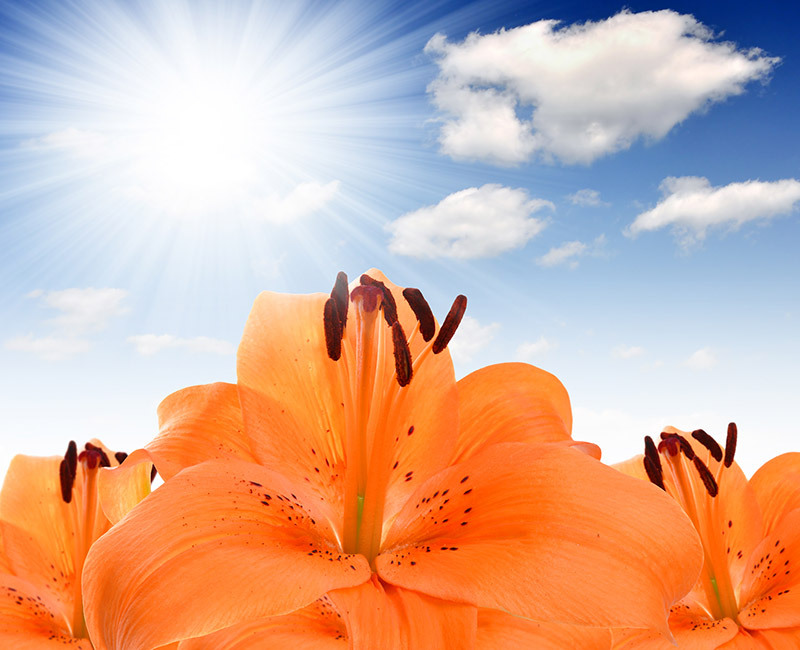Guide to Prolonging Poinsettia Lifespan
Posted on 14/08/2025
Guide to Prolonging Poinsettia Lifespan
Poinsettias are a beautiful and festive plant beloved for their vibrant red, white, or pink bracts that make them a holiday staple worldwide. However, many think of poinsettias as short-term decorative plants--discarded after the holiday season. Yet, with the right care, you can prolong poinsettia lifespan and enjoy their beauty for months, or even years! This comprehensive guide unveils professional techniques, timely maintenance, and the best conditions to keep your poinsettia thriving far beyond Christmas.

Understanding Poinsettias: Origins and Characteristics
Poinsettias (Euphorbia pulcherrima) originate from Mexico and Central America, where they grow as perennial shrubs. In nature, they can reach heights of up to 10 feet! What most people call the "flowers" are, in fact, brightly colored bracts--modified leaves--while the true flowers are small and yellow, located at the center of the bracts. Understanding the native habitat and characteristics of this iconic plant is key to extending their lifespan indoors.
Key Poinsettia Attributes:
- Temperature Preferences: Thrives in temperatures between 60?F to 70?F (15?C to 21?C).
- Lighting Needs: Loves bright, indirect sunlight.
- Water Requirements: Prefers moderate, consistent moisture--never soggy, never dry.
Factors Influencing Poinsettia Longevity
To successfully extend the lifespan of your poinsettia, it's essential to recognize the main influencing factors. Prolonging the life of poinsettias depends on:
- Proper selection at purchase
- Ideal placement in your home
- Consistent and correct watering
- Proper lighting
- Correct temperature and humidity
- Pruning and repotting
- Fertilizing
- Fending off pests and diseases
Choosing a Healthy Poinsettia
Prolonging your poinsettia's life starts at the point of purchase. A healthy plant is your best bet for longevity.
- Inspect the foliage: Leaves should be a rich green and lush, without pests or spots.
- Check the flowers: The tiny yellow buds in the center of the bracts should be intact (not dried up or missing).
- Test for wilting: Avoid plants with drooping leaves, as this indicates water stress.
- Review bract color: Bracts should be vibrant and not fading or curling at the edges.
Setting Up the Perfect Environment
The right home environment is crucial to maximize the lifespan of your poinsettia.
Best Placement Tips
- Light: Place near a sunny window that receives 6 hours of bright, indirect sunlight daily. Avoid direct midday sun that can scorch leaves or bracts.
- Temperature: Keep plants in rooms where daytime temperatures are between 65?F and 70?F (18?C-21?C) and nighttime temperatures no lower than 60?F (15?C).
- Drafts: Avoid cold drafts near windows, doors, or heating vents--abrupt temperature changes can cause leaf drop.
- Humidity: Poinsettias prefer higher humidity. In dry environments, place a pebble tray or humidifier nearby.
Watering: The Heart of Poinsettia Care
Watering is the leading care factor impacting how long poinsettias last. The goal is to keep soil lightly moist--not wet, and never fully dry.
Essential Watering Guidelines
- Frequency: Check your poinsettia's soil daily. Water only when the top inch of soil feels dry.
- Method: Water thoroughly until it drains out the bottom, then empty excess water from saucers to prevent root rot.
- Warning Signs: Yellow or drooping leaves often signal overwatering or underwatering. Adjust your routine if you notice either.
Water Quality Matters
- Use lukewarm, distilled, or filtered water when possible.
- Avoid water with high fluoride or salt content, which can damage roots or discolor leaves.
Lighting: Key to Vibrant Bracts and Healthy Growth
Light directly influences the vibrancy and persistence of a poinsettia's bracts. To extend the colorful display:
- Place your poinsettia where it gets continuous, bright, indirect sunlight. South, east, or west facing windows work well (but use sheer curtains to diffuse harsh rays).
- Rotate the pot every few days to ensure even light exposure and balanced growth.
- In low-light seasons: Consider a supplemental grow light if sunlight is insufficient (such as short, cloudy winter days).
Fertilizing for Lifelong Vigor
Poinsettias do not need fertilizer while blooming (when bracts are colorful and showy). However, after blooming--usually in late winter or early spring--feed regularly to support healthy foliage.
How to Fertilize Your Poinsettia
- Type: Use a balanced, water-soluble houseplant fertilizer (like 20-20-20 or 10-10-10).
- Schedule: Apply every 3 to 4 weeks during active growth (spring and summer).
- Method: Fertilize after watering, never on dry soil to avoid root burn.
Pruning and Repotting: Extending Poinsettia Longevity
Once the bracts fade, pruning your poinsettia sets the plant up for a new cycle of growth and a renewed display next winter. Pruning is critical for those aiming to prolong the life cycle of poinsettias into the next holiday season.
Pruning Steps:
- Cut stems back to about 4 to 6 inches above the soil after bracts fall and blooming ceases (usually late March or early April).
- Leave 1-3 healthy leaves or buds on each stem.
- Pinch back new growth in June and July to encourage bushier plants.
Repotting Techniques:
- If roots fill the container or become crowded, gently repot your poinsettia in late spring in a pot one size larger using a light, well-draining potting mix.
Encouraging Rebloom: The Dark Treatment
One of the most rewarding parts of long-term poinsettia care is getting your plant to redevelop those dazzling colorful bracts the next holiday. This requires a specific light regimen beginning in early fall:
Step-by-Step Dark Period Process
- Beginning in late September or early October, give your plant 14-16 hours of total darkness each night (closet, box, or dark room) and 8-10 hours of bright, indirect daylight each day.
- Continue this strict light/dark schedule for at least 8-10 weeks.
- Maintain warmth, moderate watering, and regular fertilizing as above.
This process triggers the color transformation in the bracts, preparing the plant to look stunning by December!
Pest and Disease Prevention for Prolonged Poinsettia Health
Vigilant care can protect your poinsettia plant lifespan from common houseplant troubles:
Watch for These Threats:
- Whiteflies: Small, white insects on the undersides of leaves. Treat with insecticidal soap or neem oil.
- Spider mites: Webbing and stippling--often in dry, overheated homes. Increase humidity and use miticides if necessary.
- Root rot: From overwatering and poor drainage; prevent by only watering when the top inch of soil is dry.
- Powdery mildew or botrytis: Appearing as gray or white patches; improve air flow and remove affected parts.
Early detection and intervention are key to poinsettia plant longevity. Quarantine any new plants before placing them near your poinsettia collection.
Common Mistakes That Shorten Poinsettia Lifespan
Even experienced plant lovers make mistakes! To ensure your poinsettia endures:
- Do not expose the plant to extreme cold--poinsettias can be damaged below 50?F and are highly sensitive to frost.
- Avoid placing poinsettias near heat sources--fireplaces, radiators, or hot air vents can dry out or scorch leaves.
- Resist overwatering--roots must breathe, so keep soil barely moist, not soggy.
- Never leave the plant in standing water--empty drainage trays after watering.
- Don't fertilize while in bloom--wait until the bracts fade.
- Don't skip the dark treatment if you want reblooming color displays next season.
Poinsettias: Myths and Safety
Are Poinsettias Poisonous?
Poinsettias are not highly toxic to humans or pets. The plant's sap may cause mild stomach upset or skin irritation, but serious consequences are rare. Keep plants out of reach of children and pets as a precaution, and always wash hands after pruning.
Year-Round Poinsettia Care Schedule
January-March: Maintain bright light, water when dry, and enjoy the bracts. Do not fertilize while blooming.
April: Cut back stems to 4-6 inches. Water minimally; place in bright light. Resume fertilizing in May.
May-September: Grow as a leafy green plant. Pinch back stems to encourage bushy growth. Fertilize monthly; consider putting the plant outdoors in partial shade during warm months.
October-November: Initiate the poinsettia rebloom ritual--begin the nightly dark period as described above. Continue regular care otherwise.
December: Move to a prominent indoor location for best display as bracts color up. Enjoy your colorful, thriving poinsettia!

Frequently Asked Questions: Prolonging Poinsettia Life
How long can poinsettias live indoors with proper care?
With ongoing proper care and timely pruning, some gardeners report growing poinsettias for 5-8 years or more, although most are renewed for 2-3 years. Annual reblooming is possible with patience and attention.
Can you keep poinsettias outside?
Yes, in climates with no frost or freezing temps, poinsettias can be grown outside year-round. Place them in partial shade and provide regular water and fertilizer. In colder climates, take them outside only after the danger of frost has passed, and bring them indoors before autumn chills.
Why are my poinsettia's leaves dropping?
This is usually due to temperature shock, overwatering, dry air, or poor light. Review your care routine and conditions, and improve accordingly.
When should I start the dark treatment?
Start in late September or early October to achieve colored bracts by December.
Conclusion: Enjoy Long-Lasting Poinsettias All Year
Poinsettias are far more than a fleeting holiday decoration. With thoughtful care, proper routines, and a little patience, you can prolong the life of your poinsettia for sustained color and joy. From picking the healthiest plant, providing the best light and water, to employing the famed "dark treatment" for reblooming, these tips can transform your poinsettia into a cherished houseplant season after season. Celebrate the holidays--and beyond--with thriving, beautiful poinsettias!
Do you have more tips for extending poinsettia lifespan? Share your experiences in the comments or connect with fellow enthusiasts--let's spread the joy and color all year long!
Latest Posts
Unveiling Your Botanical Match
Guide to Prolonging Poinsettia Lifespan
Mastering Hydrangea Care for Lush Blooms
Uncover the Secrets of Your Birth Month Flower
Understanding the Tradition of Red Roses for Valentine's Day





